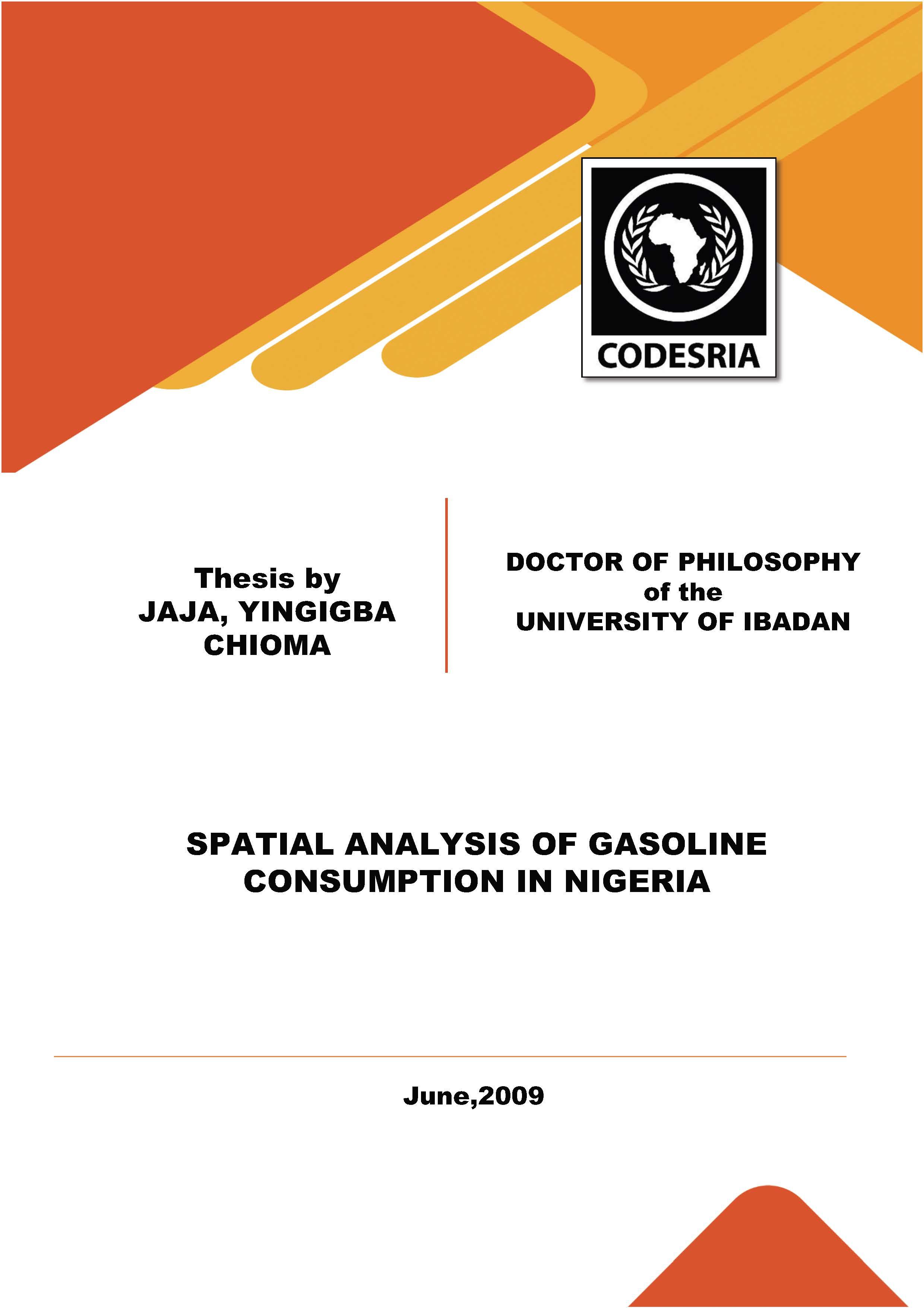SPATIAL ANALYSIS OF GASOLINE CONSUMPTION IN NIGERIA
Keywords:
Gasoline consumption, Urban structure, Intra-urban travel, Urban land-use, Spatial analysisSynopsis
Automobile accounts for the rise in traffic volume and energy consumption in the Nigeria transport sector. Land use planning and land use design are increasingly powerful tools influencing travel behaviour and gasoline consumption. However, only modest empirical evidence of this relationship exists. This study examined the spatio-temporal pattern ofgasoline consumption in Nigeria. It also investigated the relationship between gasoline consumption and urban land use in terms of location of employment, shopping and service centres with particular reference to Ibadan metropolis.
Secondary data on gasoline consumption and the explanatory variables such as per capita income and vehicle registration in the 36 States for the period 1971-2005 were collected from various government publications. Survey was conducted on 1451 households selected through systematic random sampling technique to obtain information on household intra-urban travel and socio-economic characteristics. The analysis was based on 640 vehicle owners that consumed gasoline directly for intra-urban travel. Descriptive analysis was used to explain the spatio-temporal pattern of gasoline consumption in Nigeria. Multiple correlation and regression analysis were employed to explain the determinants of the pattern of gasoline consumption, relationships between household gasoline consumption and land use variables, socio-economic and trip characteristics.
There were substantial differences in the spatial distribution of gasoline consumption among the states. Lagos State had the highest consumption level with 25.0%, followed by Oyo (6.5%), Ogun (5.4%), Kaduna (5.0%),and Edo (3.9%) States. Gasoline consumption increased from 427,937.7 litres in 1971 to 5,219,957 litres in 1983 and 8,725,938 litres in 2003.The spatial pattern was significantly explained by new registration of vehicles (p<0.01), number of industries (p<0.02) and per capita income (p<0.04) (R2=0.958).
Within Ibadan metropolis, gasoline consumption for work trips was dominated by Ibadan North (21.4%),North West (15.7%) and North East (12.1%); for school trips, Ibadan North (27.2%), North West (13.3%) and South East (12.6%); for shopping trips, Ibadan North (26.9), Ido (14.9%) and Akinyele (14.3%); for service trips, Ibadan North (22.7%), North West (14.2%) and Ido (14.2%). Number of industries (p<0.03) and recreational facilities (p<0.01) significantly explained the variation in gasoline consumption (R2 =0.811). Number of buses, gender and educational level account for the variation in gasoline consumption for work trips; number of cars and age of household head account for school trips; annual income, number of cars, household size and number of relatives account for shopping trips while annual income, number of cars and gender of household head account for service trips. Regression analysis results showed that land use variables explain 81% of the variation in gasoline consumption for intra-urban travel while socioeconomic variables accounts for only 17%. Gasoline consumption is determined by number of trips, travel time, distance and use of vehicles for work, school, shopping and service trips.
Urban spatial activities influenced travel and gasoline consumption. Therefore, there is a need to incorporate transport planning into urban planning to reduce energy consumption arising from travel and encourage the use of non-vehicular means of travel.
Downloads
References
Association of Bay Area Governments (ABAG) (1985): Jobs/ Housing Balance for Traffic Mitigation : Interstate 680 Corridor Study. Centre for Analysis and Information Services, Oakland, November.
Abler, R., Adam, J. S. and Gould, P. R. 1972. Spatial organisation : the geographers view of the world. Englewood: Prentice-Hall.
Abumere, S. I. 1994. Residential differentiation in Ibadan. Some sketches of an explanation. Ibadan region. Filani, M.O., Akintola, F.O., and Ikporukpo,C.O. Eds. Rex Charles Publication,Ibadan:85-97.
Adegbulugbe, A.O. and Dayo F.B. 1986. Demand analysis of gasoline consumption in Nigeria. OPEC Review. 10. 2:131-142.
Adelamo, I.A.1999. Urban Transportation at State and Local Government Levels. A commissioned paper for the one week Intensive Executive Course on Urban Transportation and Traffic Management. Organised by University of Lagos. May 3-7.
Ademiluyi, I. A. 1996. An analysis of spatio-temporal patterns of inequalities in Ogun state, Nigeria. PhD. Thesis.Dept of Geography. University of Ibadan.
Adeniji-Soji, J.O.1996. Patterns of telecommuting and intra-city travel: A case study of Ibadan metropolis, Nigeria.PhD. Thesis.Dept of Geography.University of Ibadan.
Adenikinju, A.F. 1995.Energy pricing policy and the environment in an oil-exporting developing country. OPEC Review Winter: 307-329.
Afolayan, A.A.1994.Population. Ibadan region. Filani, M.O., Akintola, F.O., and Ikporukpo,C.O. Eds. Rex Charles Publication, Ibadan:136-144.
Albertine van Diepen and Voogd, H. 2001. Sustainability and planning: does urban form matter? International Journal of Sustainable Development 4.1:59-74.
Alokan, O.O. and Onyemelukwe, J.O.C. 1994.Industrial development. Ibadan region. Filani, M.O., Akintola, F.O., and Ikporukpo,C.O.Eds. Rex Charles Publication, Ibadan:154-167.






